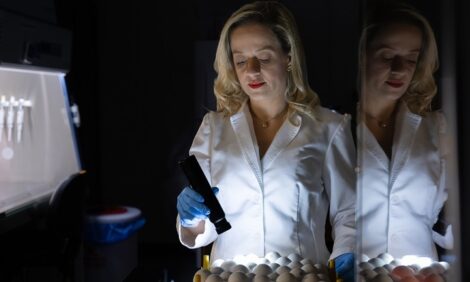



Vaccines and vaccination for the effective control of Gumboro disease
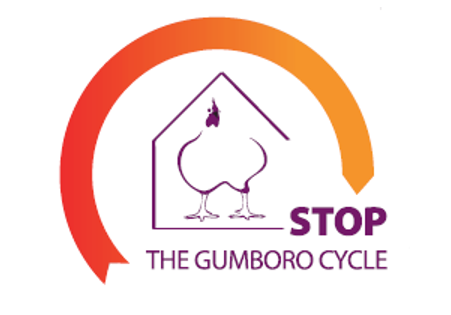
The poultry industry has evolved significantly in recent decades. The increasing demand for higher volumes, better quality and competitive prices have resulted in the industrialization, intensification and concentration of production. The latter has led to increasing pressure on animals that have better genetic, productive and efficiency potential.
In this context, the control of infectious diseases is key. Additionally, the pressure to reduce the use of antibiotics has increased, as the demands on the effective control of zoonotic agents, which has forced producers to improve and deeply understand disease control.
Biosecurity and vaccination are essential tools for the proper control of infectious diseases. Additionally, the concepts of vaccination have undergone such a revolution that they have required the definition of new health strategies.
Infectious Bursal Disease (IBD) or, more commonly known as Gumboro disease, has historically caused great losses to industrial poultry and is classified as one of the main diseases in almost all countries of the world.
List of notable diseases by The World Organisation for Animal Health (OIE) with importance in 2017:
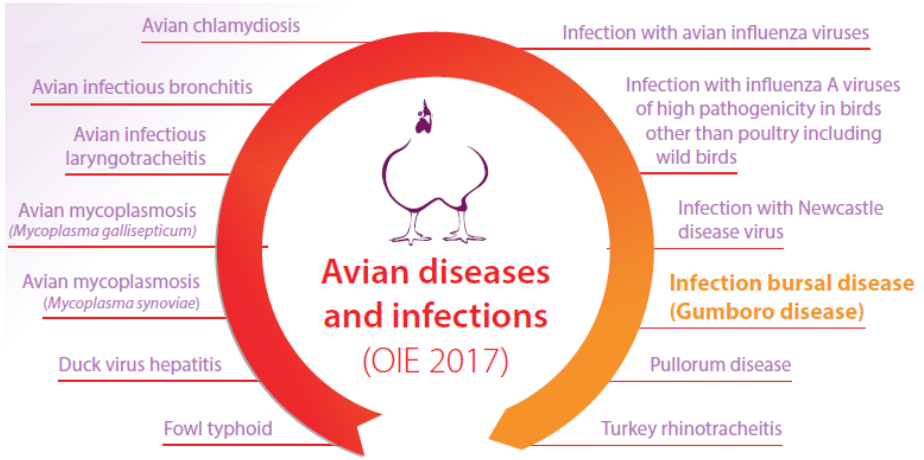
One of the reasons why the disease continues to challenge birds is that the Gumboro virus is very resistant in the environment, which allows its persistence in poultry facilities, even in the absence of chickens during downtime period.
On the other hand, the presence of vvIBDV (very virulent virus of infectious bursal disease) and variant strains has been detected not only in broilers, but also in laying pullets in all areas with industrial poultry.
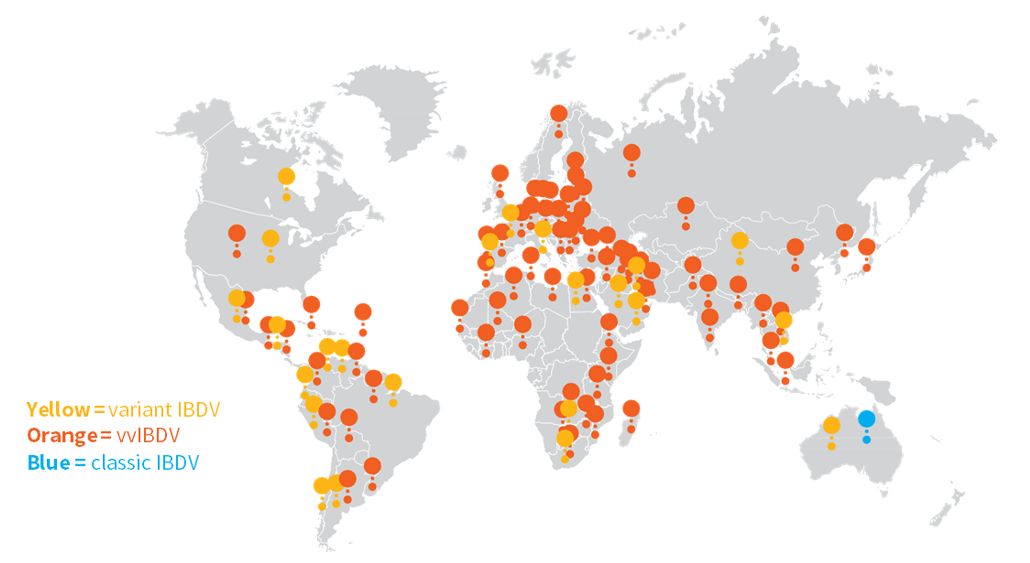
In addition to the aspects described, the control of Gumboro disease with field vaccination face some challenges:
- The level of maternal antibodies (MDA) is variable or unknown at the time of vaccination. For this reason, is the vaccine is applied in the field, the delivery of the vaccine is not uniform in all the birds in the flock. To obtain an adequate calculation of the vaccination age, it is necessary to carry out serological tests on day-old chicks, which in practice is operationally complex and represents an additional cost. Without the precise determination of the MDA level for Gumboro, there are 2 risks: the first is that early attenuated live vaccine viruses are neutralized by MDA; the second is that when vaccines are applied late, the field virus will replicate in the bursa before the vaccine strains, causing the development of the disease.
- The route of administration, mainly drinking water, itself has risks. Its success depends on the quality of the water, the successful neutralization of the chlorine before mixing the vaccine, the homogeneous distribution of the vaccine solution to all the birds, and the need for all the birds in the flock take the full vaccine dose. Therefore, it is usual to find vaccination procedures that are not optimal. Based on field evaluations in poultry companies, the vaccination rate failed due to the described reasons usually varies between 30 to 50% of chickens (W. van der Sluis, World Poultry 2012).
The development of immune complex vaccines was aimed to solve these problems by providing a totally new approach to vaccination against Gumboro disease:
- Vaccines are applied in the hatchery (in ovo or subcutaneous vaccination) using automated injection equipment, which can be regularly calibrated and checked to provide a constant dose;
- The formulation of the immune complex vaccines allows the attenuated vaccine virus to not suffer interference by the maternal antibodies against the Gumboro disease virus and, therefore, the delivery of the vaccine is safe, regardless of the level of immunity transferred by breeders.
What is an immune complex vaccine for IBD?
It consists of the suspension of live attenuated Gumboro virus (intermediate plus strain) combined in well-defined proportions with antibodies. In this way, the vaccine virus is covered by specific immunoglobulins (Virus Protective Immunoglobulins, or VPIs) that protect it and prevent it from being recognized by the birds' immune system.
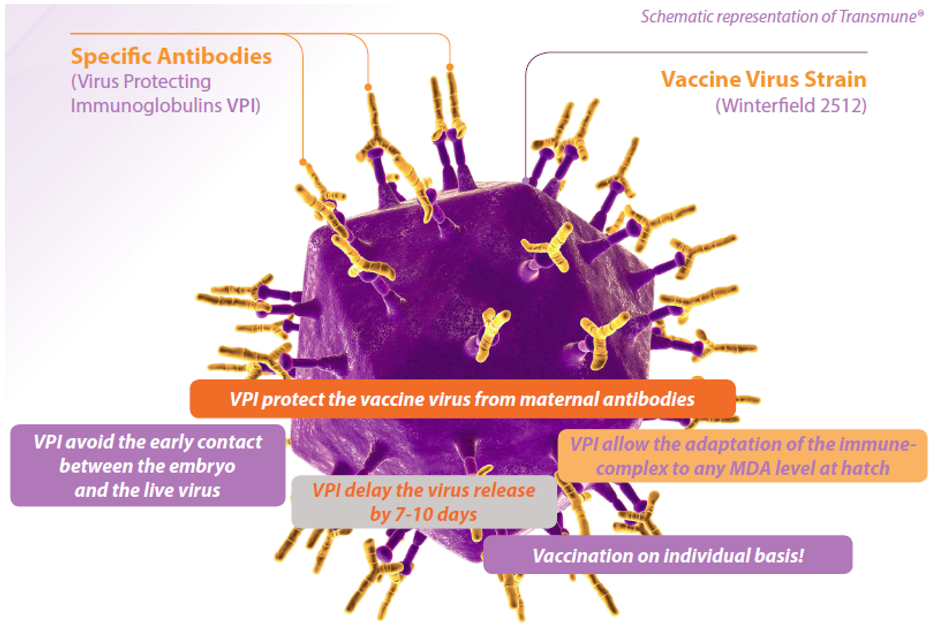
Transmune® is composed by Winterfield 2512 strain of Gumboro disease virus with specific antibodies and its use is indicated in broilers and broilers breeders.
And for layers and slow growing birds, Novamune® was developed with the attenuated SYZA26 strain of Gumboro disease virus, forming immune complexes with specific immunoglobulins for application in this type of birds with slower growing.

Due to the importance of the adequate balance between the vaccine virus and the specific antibodies, in both vaccines multiple tests with different formulas were necessary before their introduction to the market in order to obtain an optimal balance of the safety and efficacy.
To guarantee the uniformity of all vaccine batches, and as both vaccines were developed and registered in the European Union, a special quality control procedure was designed to maintain the efficacy and safety of each series produced, which consists of a rigorous test on each batch when using a CID50 (infective dose of embryo chicken).
How do Transmune® and Novamune® work?
After administration of the vaccine by injection, the follicular dendritic cells of the spleen retain the immune complexes and after few days, the vaccine virus begins to be released gradually.

From the first day, the MDA levels will decrease. This decrease is variable according to the starting MDA level at hatch. The vaccine take occurs when the MDA level decreases, as a consequence of normal catabolism, to a point that allows vaccine strain to be released and to reach the bursa of Fabricius, and induce the protective immune response.
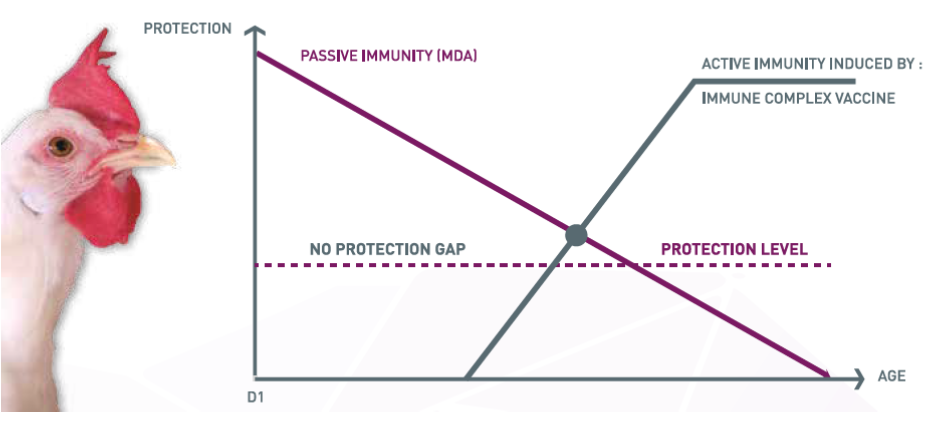
The primary goal of immunizing birds against IBD is to achieve colonization of bursa with the vaccine virus. This event will block the bursa against Gumboro field virus infections, the consequences of which will be:
- A properly immunized bird will be protected against clinical and subclinical disease.
- The protection will allow the bird an adequate development and productive performance.
- Decrease of the excretion of challenge viruses in the farm environment, an essential aspect for the environmental control of the disease.

The protection of immune complex vaccines is similar to that of live vaccines, with the added advantage that all birds are immunized with the same well-controlled dose of vaccine. Additionally, immunizations with this type of technology, cycle by cycle, decrease the viral pressure, and, consequently, no selection pressure in the viral population of the farm and true control of the disease is achieved.
After 15 years of use in the field, immune complex vaccines have become highly relevant, as it meets the demands of the industry for the effective control of Gumboro disease:
- Contain an attenuated virus that replicates rapidly in the bursa;
- A correct balance formulation of antigen and antibody to guarantee efficacy and safety.
- Effective with only one dose applied in the hatchery;
Since its launch 15 years ago, Transmune® has been used in more than 110 billon birds worldwide, the most used tool for control Gumboro disease in broilers.
And since the launch of Novamune®, it has positioned itself as the reference vaccine for Gumboro control in layers and slow growing birds based on its characteristics of efficiency, safety and convenience.








